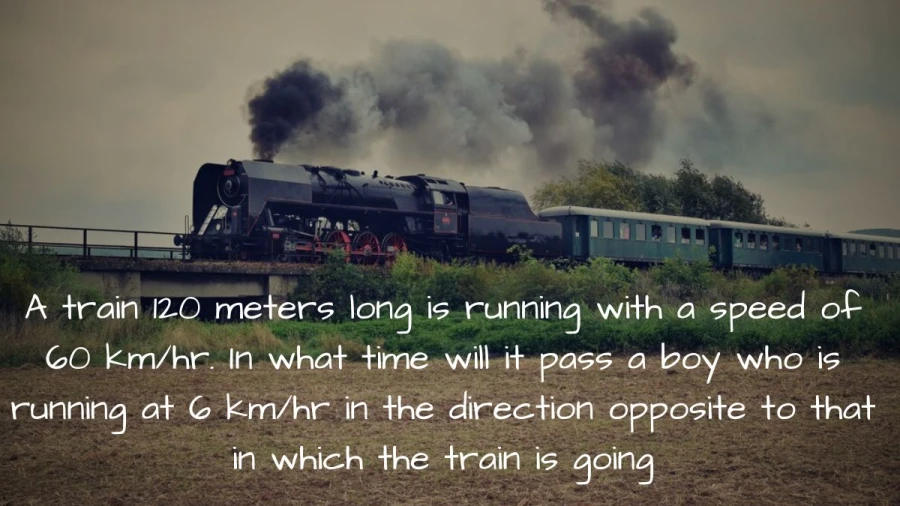If you happen to be viewing the article A train 120 meters long is running with a speed of 60 km/hr. In what time will it pass a boy who is running at 6 km/hr in the direction opposite to that in which the train is going? ? on the website Math Hello Kitty, there are a couple of convenient ways for you to navigate through the content. You have the option to simply scroll down and leisurely read each section at your own pace. Alternatively, if you’re in a rush or looking for specific information, you can swiftly click on the table of contents provided. This will instantly direct you to the exact section that contains the information you need most urgently.
Find out how long it will take for a 120-meter train, traveling at 60 km/hr, to overtake a boy running at 6 km/hr in the opposite direction.
A train 120 meters long is running with a speed of 60 km/hr. In what time will it pass a boy who is running at 6 km/hr in the direction opposite to that in which the train is going?
It will take approximately 6.545 seconds for the train to pass the boy.
To solve this problem, we need to find the time it takes for the train to pass the boy.
When the train passes the boy, the relative speed between the train and the boy is the sum of their speeds since they are moving in opposite directions.
Article continues below advertisement
Given:
- Length of the train (L) = 120 meters
- Speed of the train (Vt) = 60 km/hr
- Speed of the boy (Vb) = 6 km/hr
First, we need to convert the speeds to meters per hour because the length of the train is in meters. 1 km/hr = (5/18) m/s (To convert km/hr to m/s) So, the speed of the train in m/s = (60 * 5/18) m/s = 50/3 m/s And the speed of the boy in m/s = (6 * 5/18) m/s = 5/3 m/s
The relative speed of the train and the boy = (Speed of train) + (Speed of boy) Relative speed = (50/3) + (5/3) m/s = 55/3 m/s
Now, we can find the time taken for the train to pass the boy using the formula: Time = Distance / Speed
Time = (Length of train) / (Relative speed) Time = 120 meters / (55/3) m/s Time = (120 * 3) / 55 seconds Time ≈ 6.545 seconds
So, it will take approximately 6.545 seconds for the train to pass the boy.
Distance, Speed and Time
Distance, speed, and time are interrelated concepts that describe the motion of an object. They are connected through a simple formula:
Speed = Distance / Time
This formula allows you to calculate any of the three quantities if you know the other two. Here’s a breakdown of each:
- Distance: This refers to the total amount of ground covered by the object, typically measured in units like meters, kilometers, miles, etc.
- Speed: This indicates how fast the object is moving, usually expressed in units like meters per second, kilometers per hour, miles per hour, etc. Speed is a measure of both the magnitude and direction of the movement.
- Time: This represents the duration for which the object is in motion, typically measured in seconds, minutes, hours, etc.
Here are some additional points to consider:
- The relationship between these three quantities is indirectly proportional. This means that if one quantity increases, the other two quantities will decrease proportionately (and vice versa). For example, if the speed of an object doubles, the time taken to cover a certain distance will be halved, assuming the distance remains constant.
- You can rearrange the formula to solve for any of the three variables. For instance, to find the distance traveled, you can use the formula: Distance = Speed x Time. Similarly, to find the time taken, you can use: Time = Distance / Speed.
- It’s crucial to ensure that the units used for distance, speed, and time are consistent when applying the formula.
Understanding these concepts is essential in various real-world applications, from calculating travel times to determining the speed of objects in science experiments.
Article continues below advertisement
Article continues below advertisement
Thank you so much for taking the time to read the article titled A train 120 meters long is running with a speed of 60 km/hr. In what time will it pass a boy who is running at 6 km/hr in the direction opposite to that in which the train is going? written by Math Hello Kitty. Your support means a lot to us! We are glad that you found this article useful. If you have any feedback or thoughts, we would love to hear from you. Don’t forget to leave a comment and review on our website to help introduce it to others. Once again, we sincerely appreciate your support and thank you for being a valued reader!
Source: Math Hello Kitty
Categories: Math

